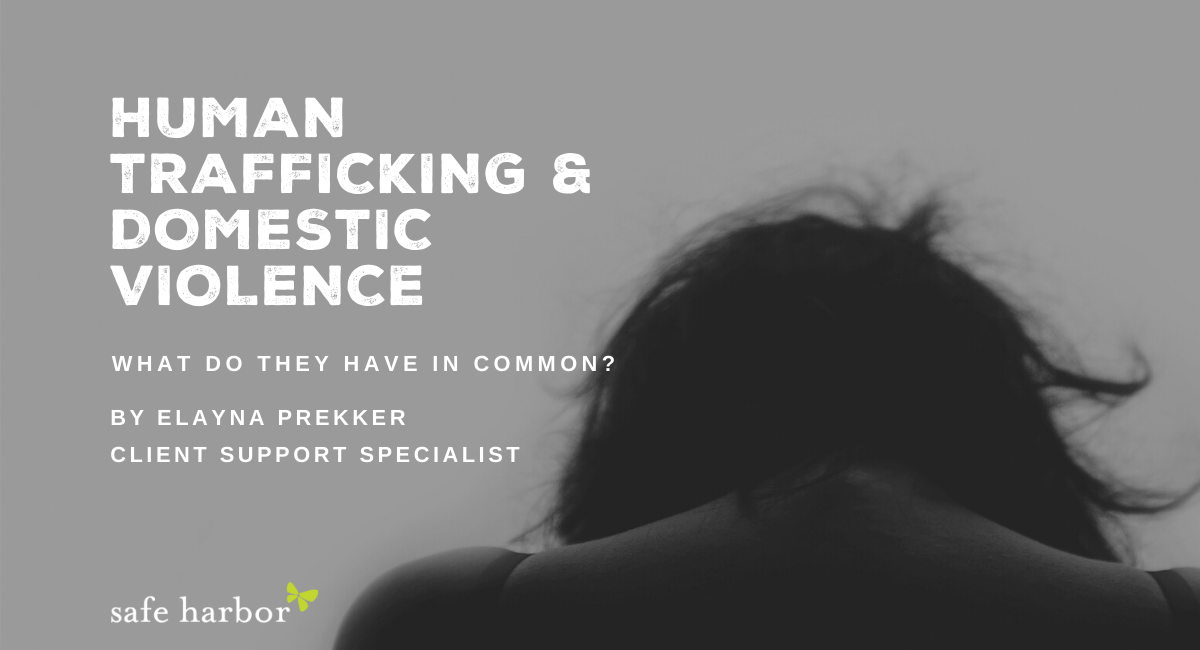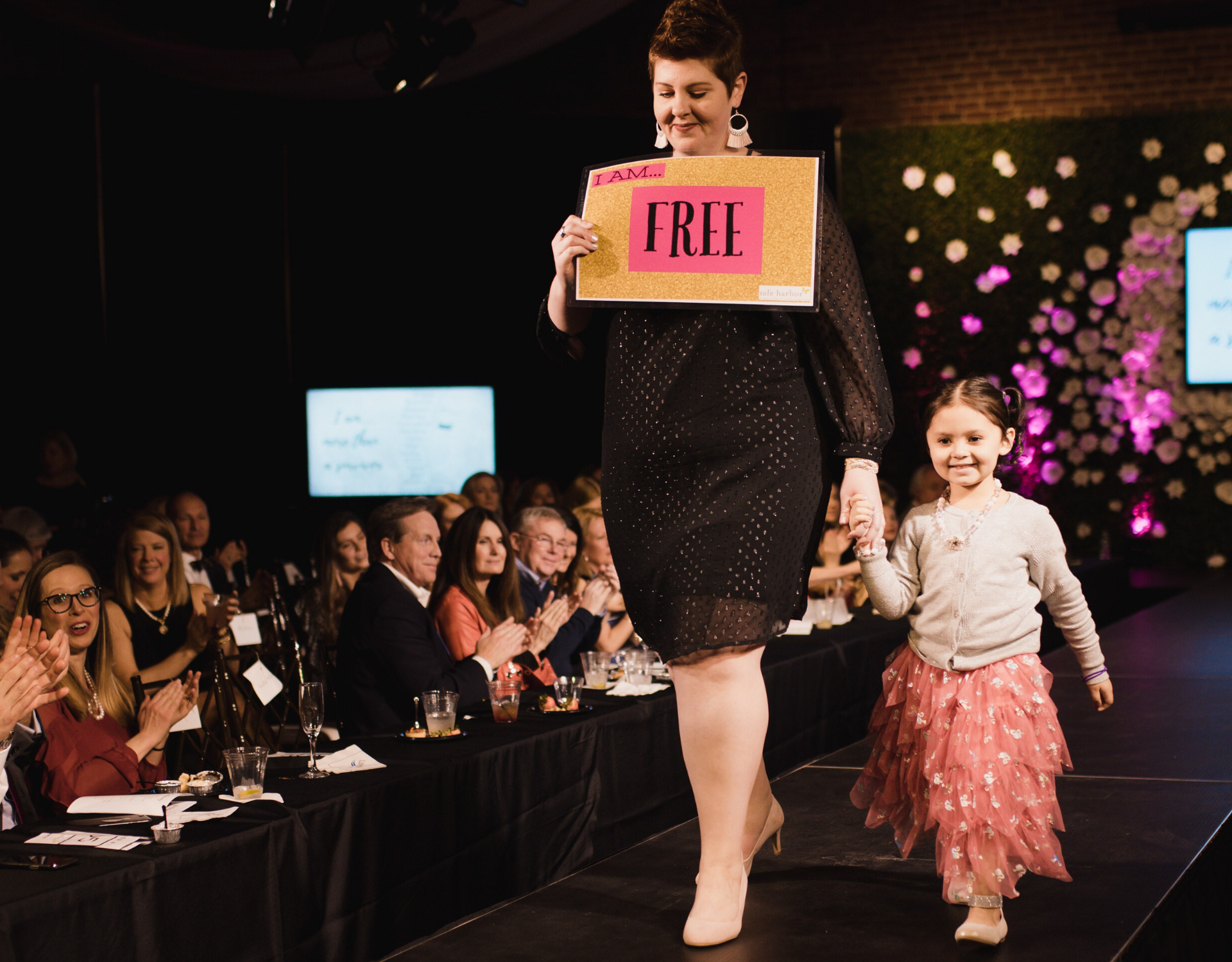Domestic Violence And Human Trafficking Have A Lot In Common
By Elayna Prekker, Client Support Specialist
January is Human Trafficking Awareness Month. You may be thinking, it’s great that you are highlighting that this month, but does this actually have anything to do with domestic violence? Well, yes. It does!
Here at Safe Harbor, being an emergency shelter for domestic violence, we also will serve clients who are coming from human trafficking or from a relationship with a trafficker. This is because they are coming from a dangerous or lethal situation as well, and have an abuser who is seeking to do them continued harm. Many of the power and control dynamics seen in a domestic violence relationship are also seen in human traffickers and their victims.
We can see this in some myths that are similar for both epidemics.
Myth 1. DV or human trafficking could never happen in my family or my community.
Fact: Human Trafficking rarely looks like the white van abduction of a young woman. It can, but it is not common. It is more common that manipulation, power and control, and preying on vulnerabilities result in human trafficking. Domestic Violence affects every race, gender/gender expression, community, and religion. It can happen, not only in your community, but even in your family. Recent statistics according to the NCADV (2021) state that 42.3% of women and 29.2% of men experience forms of DV.
Myth 2. DV and Human Trafficking always look like forced sex and violent physical abuse.
Fact: It is true that both of these are part of DV and trafficking. Abuse like this, however, goes far deeper. Intimidation, gaslighting, honeymoon periods (apologies or kind care), manipulation, and guilt-tripping are all power and control techniques to keep a victim in the abuser’s grasp. For example, after the “honeymoon period” there may be manipulation to make the victim feel guilty for complaining about an assault or argument or for not contributing to the needs of the abuser (I.e. financial income by having sex with other people).
Myth 3. Victims of DV or Human Trafficking put themselves in these situations. They should have known better.
Fact: This is a toxic myth that creates societal indifference to the brutal abuse. Domestic Violence victims are often put in a whirlwind of emotions and cycles. There is a common cycle that occurs in a DV relationship. The first instance after a beginning of manipulation and steady chipping away at the victim/survivor’s moral and self-image is tension building. This is when the quiet manipulation becomes more outspoken. More nitpicking, annoyance, put-downs, or withholding affection are some examples of this point. The victim will try to appease, stay calm, or avoid arguments with their abuser.
Then comes the “acute explosion” where a physical or incredibly emotional abuse instance occurs. Throwing items at or near the victim, explosive name-calling and humiliation, physical assault, or rape may occur.
After that a honeymoon period will begin with the abuser feeling bad or apologizing, trying to explain what happened or ask for help. However, there may be threats of suicide or self-harm as “self-punishment”. The victim will forgive, return, help, believe they can change their abuser. We cannot assume this is because they are foolish but really, they love and care for their abuser and want to return to what they felt was their normal, right relationship (Domestic Violence, 2022).
In Human Trafficking, often traffickers will prey on their victims' need for love, affirmation, or care. They may also prey on a person’s vulnerability due to past abuse, lack of family, homelessness, or need for basic care. They may also prey on those who are sex workers trying to make a living in potentially the only way they know how. Labor traffickers will prey on the vulnerability of poverty and the victim's desire to financially help their family. An additional note is that Human Trafficking includes child sexual exploitation. This is when a trafficker will convince a minor to do sexual deeds with them or other men in exchange for basic necessities such as food and clothing or for drugs which the minor (especially homeless) may have become addicted to (Gezenski, L, B., 2019).
Myth 4. A final myth is that domestic violence always looks physical and human trafficking always looks like people working in brothels or hotels.
Fact: While both of these occur, as we have previously touched on, both of these epidemics are very complicated, emotional, and manipulative. Emotional, financial, and digital abuse (to name some) are real forms of domestic violence. Trafficking includes labor exploitation, forced labor for no money at all, and child sexual exploitation (especially through child pornography) are all forms of trafficking. These are all abuse of humans and an attack on a victim/survivor's self-identity, worth, value, and importance.
Domestic violence and human trafficking prey on people’s vulnerabilities and needs. No matter the emotional or physical intoxication of the abuser or trafficker, these instances are not ok.
It is important that we remember that Human Trafficking is a form of domestic violence and an abusive relationship can turn into a trafficking relationship. Trafficking is and always will be the exploitation or forced (physically or emotionally) requirement to have sex or to work for the cash or value benefit of another person/people/industry. If an abuser in a relationship requires this of their spouse/significant other then this would be an instance of human trafficking. One instance does not mean that it is immediately changed into a trafficking relationship, but, it is still human trafficking.
Every person has the right to decide what happens to their body, physically or sexually. Human trafficking and Domestic Violence infringe on that right. I hope this post has helped you see the similarities of these epidemics and create a desire to speak out against both. I want to finish this post with sobering statistics about Human Trafficking in SC and in the US. This is to dispel the myth that human trafficking is not around us. There is also an attached website to help learn the signs of human trafficking. If you ever see something concerning, there is a hotline you can call to report this. Thank you for reading and being an advocate against human trafficking and domestic violence!
Federal Hotline- 1-866-347-2423
If you are a victim of human trafficking please call- 1-888-373-7888 or text HELP to BeFree (233733)
Click this link to read about recognizing signs of human trafficking.
Click this link to learn about The Exodus Road
Statistics
- In 2020 there were 121 human trafficking cases reported in South Carolina. (This is reported, meaning there are most likely many more). There were also approximately 200 identified victims or survivors that called the hotline in 2020.
- In the US, 10,583 trafficking cases were reported this year. There were also approximately 17,000 high and moderate level victims or survivors who called the national hotline.
- These numbers are sobering as these are not all of the cases. Some states are worse than others; all states have occurrences. Furthermore, these are not all of the cases that exist or all of the instances of human trafficking, as we discussed.
Information retrieved from:
National Human Trafficking Hotline - SC
National Human Trafficking Hotline - States
References:
Domestic Violence: It’s Everybody’s Business. (n.d.). Step by step guide to understanding the cycle of
Violence. https://domesticviolence.org/cycle-of-violence/
Gezenski, L.B. (2019). (De)criminizalization of survivors of domestic minor sex trafficking: A social work
call to action. Social work, 66, 3 (pp.236-244).
National Coalition Against Domestic Violence. (2021). Domestic violence in South Carolina.




